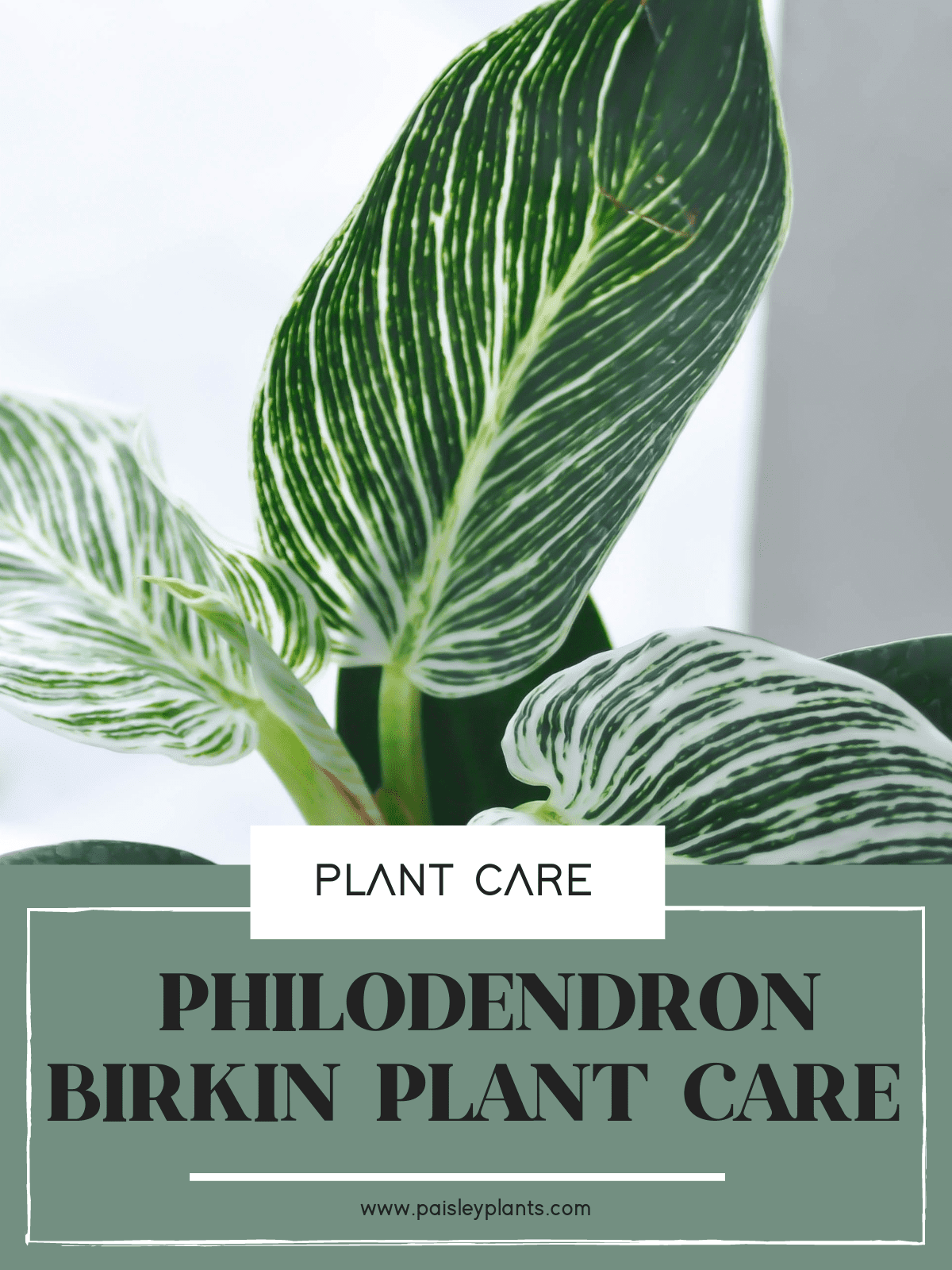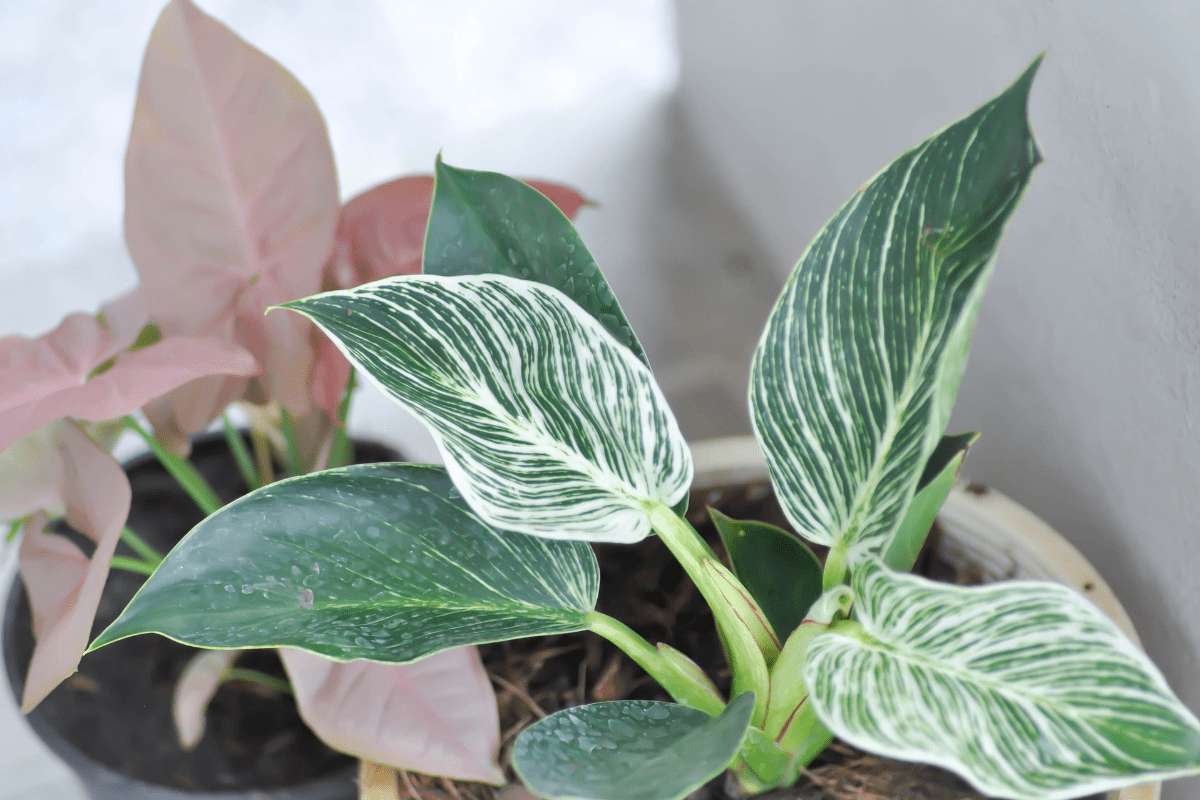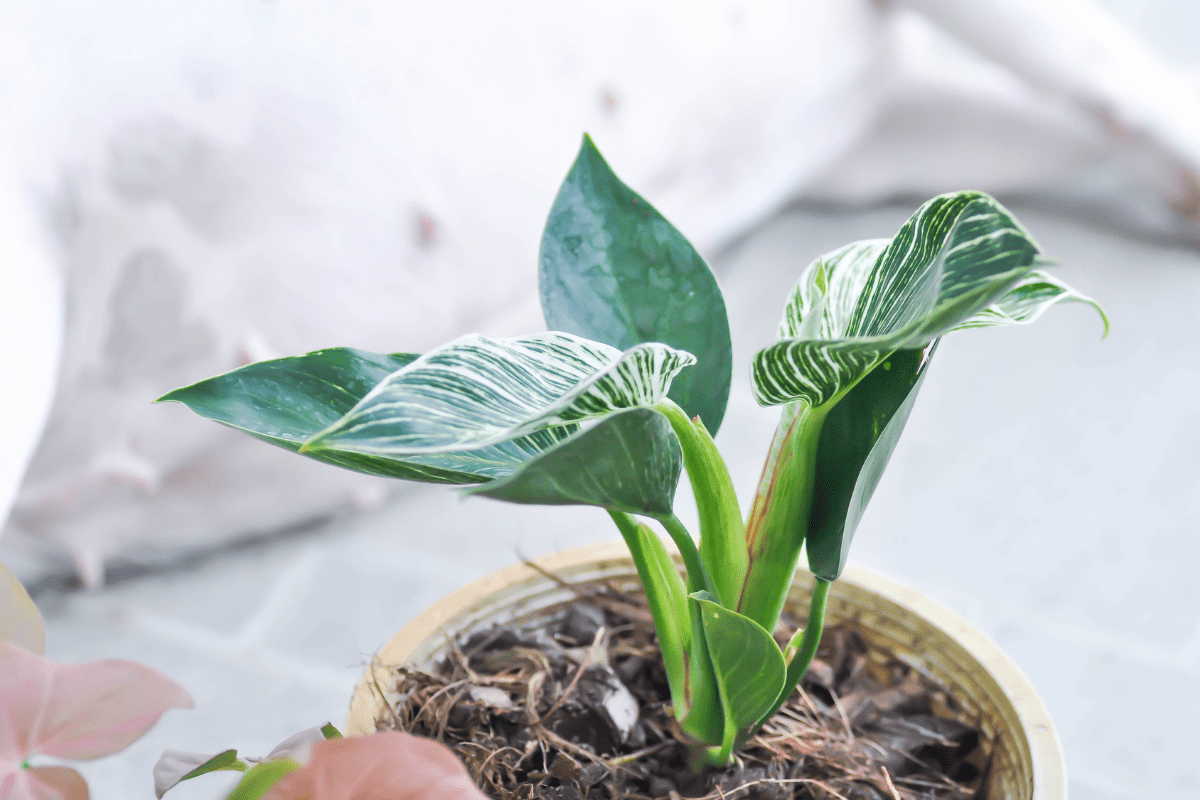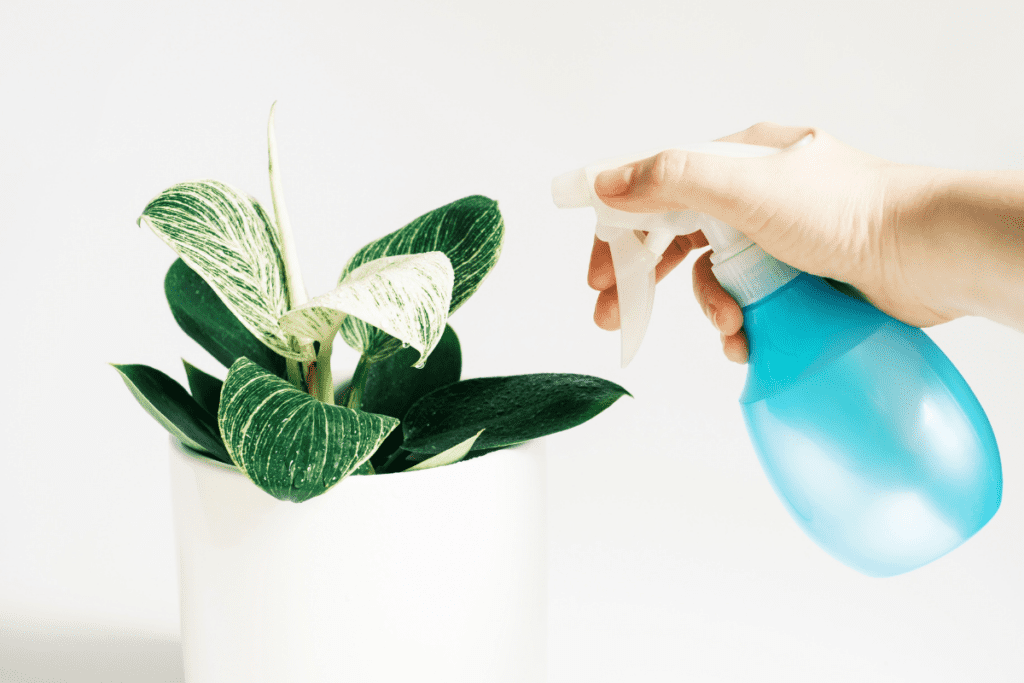Rare, beautiful, and surprisingly low-maintenance: if you’re looking for a plant that checks all these boxes, then the philodendron birkin is for you!
Known for its stunning green and white leaves, this is one plant that will be a show stopper in any home. Read on for this ultimate care guide to grow and care for a Philodendron Birkin.

This post includes affiliate links.
Table of Contents
Birkin Background
The Philodendron birkin is a beautiful plant and one of the rarer members of the philodendrons. The birkin is particularly unique in that it does not technically have a “native region.” The philodendron birkin is the creation of selective cultivation and therefore does not naturally occur in the wild. However, their close relatives are native to South America.
What really makes the philodendron birkin stand out is its striking leaves with variegation. This plant is sometimes also referred to as the “white wave” philodendron due to its unique pattern on its leaves. The leaves of the birkin are heart-shaped and green with white, wavy stripes adorning it.
While most birkin plants have white and green leaves, they also sometimes grow red and white colored leaves. Their leaves are similar to fingerprints where no two leaves are the same! The leaves of this plant are an oval shape.
Due to its man-made origins and rarity, the philodendron birkin is named after the birkin bag- one of the most expensive and sought-after designer line of pocketbooks.
And it’s only fitting that this beauty of a philodendron is named after high-end fashion. A Philodendron Birkin might not be as expensive as their namesake pocketbook, but owning a Philodendron Birkin will definitely turn the heads of your guests.
Philodendron Birkin Care

Let’s talk about all the Philodendron Birkin plant care tips you need!
Philodendron Birkin Light Requirements
When it comes to Philodendron Birkin light requirements as an indoor plant, you should ideally place your plant in a location that receives bright indirect light for most of the day, with small amounts of direct sunlight.
Please avoid placing your Birkin in a location that receives too much direct light, as this can cause the leaves to look washed out, or worse, damage the leaves.
The best type of light for these plants is sunlight that comes through a sheer curtain or in a spot just out of reach of direct sunlight. These plants respond best to indirect light and the white of their leaves can get even more white when the light conditions are optimal!
If you don’t have a spot that gets enough light, you can always use a grow light to mimic the sun!
Philodendron Birkin Soil Type
The ideal Philodendron Birkin soil type is one that is simultaneously water-retentive while also well-draining and airy. Try looking for an aroid soil.
These soils usually contain materials such as peat, perlite, charcoal, and orchid bark. Some gardeners also opt to simply plant their philodendron in pure peat moss which provides both aeration and moisture retention.

Water
Your plant prefers to live in a soil that is consistently moist. Make sure to water your birkin deeply and thoroughly, allowing the excess water to pass through the drainage holes.
You can let your philodendron slightly dry out in between watering sessions, but don’t allow the soil to stay dry for too long. As a good measure, wait until the top 1/2 inch of soil to dry in between watering.
An easy way to monitor the water needs of your plant is to do the finger test. Stick your finger into the soil of your Birkin. If it feels dry and soil does not stick to your finger, it is time for a watering.
On the other hand, if the soil of your plant feels wet and the soil sticks to your finger then don’t water it. Over watering can cause root root (more on that below).
As I like to mention, if your plant is in a clay pot such as a terracotta pot, the soil will dry out much quicker than a plant in a glazed or plastic pot.
Birkin Fertilizer
Fertilizing your philodendron is an excellent way to assist with growing a large, healthy plant. You can select a fertilizer that is specially tailored for houseplants.
Since the philodendron birkin is not a vigorous grower, you’ll only need to use the fertilizer sparingly. Only fertilize your plant once a month during the growing season (spring and summer). Completely stop fertilizing your plant during fall and winter when it is in dormancy.
Birkin Temperature & Humidity
Just like many other philodendron plants, the birkin enjoys a warm climate with high humidity. These plants are tropical plants from the rain forest where the humidity levels are incredibly high! It’s best to try to mimic that level of humidity in your home if possible.
For best results, you should place these house plants in an area of the home that is between 75° to 85° F, though a minimum of 60° F is suitable as well.
Your philodendron will be tolerable of normal household humidity levels, but keep in mind part of their growth is dependent on a environment with high humidity. They won’t do well in too much dry air.
If you would like to increase the humidity level of your home for your plant, including an electric humidifier is always a great option. You can also try misting them to mimic humidity during the spring and summer months.
Some people also like to use pebble trays to add humidity for their plants. Fill a tray or plate with pebbles and add water to it. As the water evaporates it will increase the humidity for the plants near it!

Birkin Pruning & Maintenance
The philodendron birkin is a very slow-growing species of philodendron, and therefore will not require frequent pruning. The only maintenance I would really recommend is to prune any dead or damaged foliage as you see it.
One thing you should do is to wipe down the leaves of your plant from time to time to keep them clean of dust and clear of any bugs. I simply get a damp cloth or paper towel and wipe the top and bottom of each leaf and let them air dry.
Choosing a Container & Repotting your Birkin
The most important aspect of choosing a container for your philodendron birkin is drainage. Plants such as the philodendron enjoy a consistently moist soil, which can open your plant to the possibility of being over-watered.
Having a plant pot with a drainage hole reduces the risk of waterlogged soil by allowing excess moisture to freely pass through.
Also, since the birkin is a slow-growing species of philodendron, you will not have to size your pot up very often; most likely you will only need to repot to a larger planter every 3 to 5 years, depending on the plant’s growth.
Be sure to get a pot you like since it will be in there for quite some time! However, I advise you to switch out the potting mix every year just to keep your plant in a fresh environment.
Philodendron Birkin Propagation
Let’s talk philodendron birkin propagation! Like with many philodendron plants, you can propagate this plant using stem cuttings. Follow these easy tips to multiply your philodendron plant.
- Take a healthy stem cutting from your plant. This cutting must have at least one leaf node; cut under the node. Remove the bottom leaves from the stem, only leaving about 2 to 4 leaves at the top of the plant.
- (Optional) Dip the cut-end of the plant into hormone rooting powder. Hormone rooting powder significantly raises the odds of a successful propagation, though this is entirely unnecessary and is just an extra step if you choose to do so.
- Prepare a small plant pot with airy, well-draining soil (or simply a pot filled with peat moss). Moisten the potting mix with water ahead of time.
- Plant the cut-end of the plant cutting in the potting mix, making sure that all leaves are still above the surface of the soil to allow for air circulation.
- It takes roughly one month for roots to grow and for your plant to become established. During this time, please ensure that your potting mixture remains consistently moist (water when it gets dry). Also be sure to place your stem cutting in a location that receives bright, indirect light.
- You’ll know rooting has occurred when you give your plant a little tug and you’re met with resistance.
Common Pests in Philodendron
The most common pest you might find attacking your philodendron is the spider mite. Spider mites are tiny, reddish-brown pests that suck the nutrients right out the leaves of your plants.
Since these pests are so minuscule, you might not see the pest themselves, but rather the damage they do to the foliage of your plants. Spider mite damage leaves behind small yellow spots all over your plant where they sucked out the nutrients.
While spider mites are not an enjoyable pest to have in your houseplants, they are completely treatable with a store-bought insecticidal soap. In addition, applying neem oil is a natural alternative to stifle a spider mite infestation.
Common Diseases in Philodendron
Like with many houseplants, this plant is susceptible to fungal diseases, namely root rot which is often caused by over watering combined with poor drainage. Over time, excess water gets trapped within the soil and causes the roots to break down. Signs of this in a philodendron include drooping, yellow leaves.
While it is deadly, it can be remedied with intensive care. If you suspect your plant has become a victim of over watering, follow these steps:
- Remove your plant from its pot and gently shake away excess dirt.
- Inspect the roots of your plant; rotted ones are mushy and black compared to the firm, off-white color of healthy ones.
- Take a sterile pair of scissors and cut off any rotted roots you see.
- Repot your plant with clean, new soil in a pot that has drainage holes.
The best way to treat root rot is to prevent it from ever happening in the first place. Always make sure you properly water your plant, making sure that the soil is not overloaded with water. In addition, always make sure your container has unobstructed drainage holes at the bottom to allow extra water to easily pass through.
Common Problems
New Leaves Reverting
If you have new growth that are just dark green leaves and don’t have the classic white variegation, your plant may be reverting. Be sure to give it enough sunlight so it keeps it’s beautiful white variegation!
Drooping Leaves
Drooping leaves are typically a sign that your plant needs water. If it doesn’t perk up with a day of watering it, check for any cold drafty windows, doors or vents that could be putting it into stress.
Curling Leaves
If your leaves are curling, this typically means your plant is underwatered or overwatered. Always be certain to check the soil before you water it to see if it is too dry or too wet and make sure it has good drainage.
Brown Leaves
Brown leaves could be a variety of problems – it could be sunburn from getting too much light. It’s possible there’s root rot from sitting in too much water or getting too much fertilizer.
The final culprit could be not enough humidity. Choose the most likely problem and fix that before trying another one!
Where to Buy Philodendron Birkin Plants
There’s a few places to buy philodendron birkin plants. Here’s where to check:
Birkin FAQ
Yes, the philodendron birkin is considered to be one of the rarer members of the philodendron group. The birkin is rare due to the fact that this is a man-made cultivar of philodendron, combined with the fact that they are very slow-growing and it takes a considerable amount of time to raise a birkin plant to full maturity.
Yes, this philodendron plant is toxic, though it is not known to be deadly. The reason philodendrons such as the birkin is toxic is due to the calcium oxalate crystals in its foliage.
Consumption of this causes irritation in the mouth and the digestive system, which is very unpleasant. Regardless, it is still a good idea to keep these plants out of reach from pets and curious children who might try to take a bite out of your plan
Philodendron birkins are truly a gem of the philodendrons. They are not only beautiful and fascinating, but they are extremely easy to care for. Philodendrons are very stylish and look amazing in your home’s decor, and they won’t burden you with any lofty demands.
I hope this care guide helps you know exactly how to grow and care for these beautiful plants!
Want more plant care guides? Head to one of these posts!

